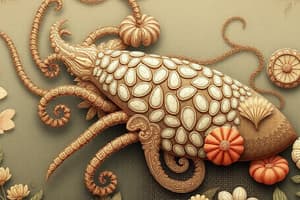Podcast
Questions and Answers
Sea Squirts are filter feeders that live on the seafloor.
Sea Squirts are filter feeders that live on the seafloor.
True (A)
Jawless Fishes have a bony skeleton and smooth, scaly skin.
Jawless Fishes have a bony skeleton and smooth, scaly skin.
False (B)
CarTlaginous Fishes lack gill covers and have bodies covered with dermal denticles.
CarTlaginous Fishes lack gill covers and have bodies covered with dermal denticles.
True (A)
Bony Fishes exhibit external fertilization, with females depositing eggs and males depositing sperm into water.
Bony Fishes exhibit external fertilization, with females depositing eggs and males depositing sperm into water.
Lampreys are solely filter feeders and do not exhibit parasitic behavior.
Lampreys are solely filter feeders and do not exhibit parasitic behavior.
Ray-finned fishes have fins supported by parallel bony rays that are devoid of muscles.
Ray-finned fishes have fins supported by parallel bony rays that are devoid of muscles.
All vertebrates possess a vertebral column that replaces the embryonic notochord.
All vertebrates possess a vertebral column that replaces the embryonic notochord.
Lobe-finned fishes, including lungfish, have paired fins that consist of muscular lobes supported by a central core of bones.
Lobe-finned fishes, including lungfish, have paired fins that consist of muscular lobes supported by a central core of bones.
All bony fishes lack swim bladders that assist in regulating buoyancy.
All bony fishes lack swim bladders that assist in regulating buoyancy.
Vertebrates exhibit a closed circulatory system where blood is contained within blood vessels.
Vertebrates exhibit a closed circulatory system where blood is contained within blood vessels.
Molluscs strictly live in marine environments and cannot inhabit freshwater or terrestrial habitats.
Molluscs strictly live in marine environments and cannot inhabit freshwater or terrestrial habitats.
Bivalves possess a well-developed head and radula.
Bivalves possess a well-developed head and radula.
Cephalopods have a notably developed sense organ that aids in their predatory behavior.
Cephalopods have a notably developed sense organ that aids in their predatory behavior.
Flatworms have a complete digestive tract with two openings.
Flatworms have a complete digestive tract with two openings.
Arthropods have a soft exoskeleton composed of chitin, which must be molted as they grow.
Arthropods have a soft exoskeleton composed of chitin, which must be molted as they grow.
All insects have two pairs of wings, regardless of their species.
All insects have two pairs of wings, regardless of their species.
The body of an insect is always divided into three parts: head, thorax, and abdomen.
The body of an insect is always divided into three parts: head, thorax, and abdomen.
Echinoderms exhibit bilateral symmetry as adults, while their larvae demonstrate radial symmetry.
Echinoderms exhibit bilateral symmetry as adults, while their larvae demonstrate radial symmetry.
Chordates can be categorized into vertebrates and nonvertebrates based on the presence of a vertebral column.
Chordates can be categorized into vertebrates and nonvertebrates based on the presence of a vertebral column.
All cephalopods are capable of living in freshwater environments.
All cephalopods are capable of living in freshwater environments.
Flashcards
Urochordates
Urochordates
Sea squirts; marine filter feeders with thick outer coverings.
Vertebrates
Vertebrates
Chordates with a vertebral column, skull, and endoskeleton.
Vertebral column
Vertebral column
Embryonic notochord replaced by a structure that protects the spinal cord and supports the body.
Endoskeleton
Endoskeleton
Signup and view all the flashcards
Jawless Fishes
Jawless Fishes
Signup and view all the flashcards
Jawed Fishes
Jawed Fishes
Signup and view all the flashcards
Cartilaginous Fishes
Cartilaginous Fishes
Signup and view all the flashcards
Bony Fishes
Bony Fishes
Signup and view all the flashcards
Swim bladder
Swim bladder
Signup and view all the flashcards
Ray-finned Fishes
Ray-finned Fishes
Signup and view all the flashcards
Molluscs (Phylum Mollusca)
Molluscs (Phylum Mollusca)
Signup and view all the flashcards
Bivalves (Class Bivalvia)
Bivalves (Class Bivalvia)
Signup and view all the flashcards
Gastropods (Class Gastropoda)
Gastropods (Class Gastropoda)
Signup and view all the flashcards
Cephalopods (Class Cephalopoda)
Cephalopods (Class Cephalopoda)
Signup and view all the flashcards
Annelids (Phylum Annelida)
Annelids (Phylum Annelida)
Signup and view all the flashcards
Flatworms (Phylum Platyhelminthes)
Flatworms (Phylum Platyhelminthes)
Signup and view all the flashcards
Arthropods (Phylum Arthropoda)
Arthropods (Phylum Arthropoda)
Signup and view all the flashcards
Crustaceans
Crustaceans
Signup and view all the flashcards
Insects
Insects
Signup and view all the flashcards
Echinoderms (Phylum Echinodermata)
Echinoderms (Phylum Echinodermata)
Signup and view all the flashcards
Study Notes
Invertebrates (2)
- Molluscs (Phylum Mollusca) are diverse, varying in size, inhabiting marine, freshwater, and terrestrial environments.
- They include herbivores, carnivores, filter feeders, and parasites.
- There are approximately 100,000 species.
- Molluscs have three main body parts: visceral mass (internal organs), mantle (covering the visceral mass, secreting calcium carbonate, and developing gills or lungs), and foot (for locomotion, attachment, and food capture). Some have a radula (grazing and feeding structure).
- Bivalves (Class Bivalvia) have two shells closed by adductor muscles, lack a head and radula, have little cephalization, tentacles on the mantle, and a foot used for burrowing or attaching. They are filter feeders, capturing food particles from water.
- Gastropods (Class Gastropoda) are the largest class of molluscs, often having a one-piece coiled shell (although not all), and a well-developed head region. Many are marine, but some, like slugs and snails, are terrestrial.
Annelids (Phylum Annelida)
- Annelids are segmented worms, mostly marine, and have a well-developed coelom (fluid-filled cavity) that allows for independent movement of body segments.
- They have hydrostatic skeletons.
Flatworms (Phylum Platyhelminthes)
- Flatworms are flat-bodied and lack specialized circulatory or respiratory systems.
- They have a sac body plan with one opening (mouth).
- Some are parasitic, like flukes and tapeworms, with adaptations to survive in the host.
Arthropods (Phylum Arthropoda)
- Arthropods have rigid, jointed exoskeletons made of chitin.
- They molt (shed) their exoskeleton as they grow.
- Segmentation is common and each segment may have a pair of appendages (eg., legs).
- Some important groups are crustaceans (have exoskeletons, many have compound eyes, and typically 5 pairs of appendages), centipedes and millipedes (centipedes having one pair of legs per body segment, millipedes having two pairs per segment), and insects (with three body regions: head, thorax, and abdomen, three pairs of legs in the thorax, and often wings).
Echinoderms (Phylum Echinodermata)
- Echinoderms are bottom-dwelling marine animals.
- They possess radial symmetry as adults (although larvae have bilateral symmetry).
- Their endoskeletons are composed of calcium-rich plates and spines.
- Examples include starfish, sea urchins, and sea cucumbers.
Chordates (Phylum Chordata)
- Chordates are bilaterally symmetrical and deuterostomes.
- They have a notochord (a supporting rod below the nerve cord) at some point in their development (in many, the notochord is replaced by the vertebral column).
- The spinal cord is a component of the dorsal tubular nerve cord.
- Most chordates are vertebrates, possessing a vertebral column.
Studying That Suits You
Use AI to generate personalized quizzes and flashcards to suit your learning preferences.


